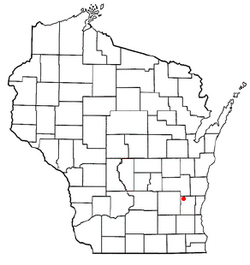Wayne, Washington County, Wisconsin facts for kids
Quick facts for kids
Wayne, Wisconsin
|
|
|---|---|

Town hall
|
|

Location of Wayne, Washington County, Wisconsin
|
|
| Country | |
| State | |
| County | Washington |
| Area | |
| • Total | 35.8 sq mi (92.7 km2) |
| • Land | 35.8 sq mi (92.7 km2) |
| • Water | 0.0 sq mi (0.0 km2) |
| Elevation | 991 ft (302 m) |
| Population
(2020)
|
|
| • Total | 2,182 |
| • Density | 48.2/sq mi (18.6/km2) |
| Time zone | UTC-6 (Central (CST)) |
| • Summer (DST) | UTC-5 (CDT) |
| Area code(s) | 262 |
| FIPS code | 55-84900 |
| GNIS feature ID | 1584389 |
Wayne is a small town located in Washington County, Wisconsin, in the United States. In 2020, about 2,182 people lived there. The smaller communities of Kohlsville and Wayne are also part of the town.
Contents
History of Wayne
Early Native American Life
Long ago, in the early 1800s, the land where Wayne is now was home to Native American tribes. The Potawatomi and Menominee people lived here. They had lived on this land for many years.
In 1831, the Menominee tribe gave up their land claims to the United States government. This happened through a special agreement called the Treaty of Washington. A few years later, in 1833, the Potawatomi tribe also gave up their land. This was part of the 1833 Treaty of Chicago.
After this treaty, the Potawatomi people were asked to leave the area by 1838. Many of them moved west to a place called Kansas. But some Potawatomi people chose to stay. They were sometimes called "strolling Potawatomi" because they moved around. They lived on their old lands, even though white settlers now owned them. Eventually, many Native people who stayed gathered in northern Wisconsin. There, they formed the Forest County Potawatomi Community.
Settlers Arrive and Town Forms
The first white settlers came to Wayne in 1846. At that time, the area was mostly thick forests. It was part of the Town of Addison.
The Town of Wayne officially became its own town on March 11, 1848. It was named after General Anthony Wayne. He was a famous general who fought in the American Revolution.
The first people to settle here were mostly from other parts of the United States, called Yankees. There were also many immigrants from Ireland. Around 1850, many German immigrants started to move to Wayne. By 1880, almost everyone living in the town was of German descent.
Growth and Development
Wayne has always been a small town. Unlike some nearby towns, it never had any railroad connections. Because of this, the small communities within Wayne, like Kohlsville and St. Kilians, stayed very rural. They mostly served the local farmers. Other towns grew bigger because of new railroads.
In the 1970s, Wayne's population started to grow more quickly. It almost doubled from 1,214 people in 1970 to 2,169 people in 2010. Even with this growth, Wayne still has a lot of open land. More than 60% of the land is used for farming. This means it has one of the lowest numbers of houses per square mile in Washington County.
Geography
Wayne covers an area of about 35.8 square miles (92.7 square kilometers). All of this area is land. There are no large lakes or rivers within the town's borders.
Population and People
In 2000, about 1,727 people lived in Wayne. The town had about 48 people per square mile. Most of the people living in Wayne were White (99.25%). A small number were Native American or Asian.
Many families lived in Wayne. About 38.5% of households had children under 18 living with them. Most households (77.3%) were married couples. The average household had almost 3 people.
The population of Wayne includes people of all ages. About 26.6% were under 18 years old. About 8.5% were 65 years or older. The average age in the town was 36 years old.
Notable People
Some important people who lived in Wayne include:
- Nicholaus Marx: He was a legislator, meaning he helped make laws.
- Gottlob E. Weiss: He was also a legislator.
See also


